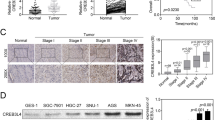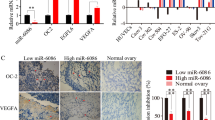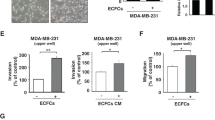Abstract
Interleukin-6 (IL-6) has received particular attention in the pathogenesis of cervical cancer, although the underlying mechanism remains elusive. This study revealed that IL-6 promotes in vivo tumor growth of human cervical cancer C33A cells, but does not substantially alter their in vitro growth kinetics. The in vivo angiogenic assays showed that IL-6 increases angiogenic activity in human cervical cancer cells, an effect that is specifically associated with upregulation of vascular endothelial growth factor (VEGF). Also, using anti-VEGF antibody to block VEGF function significantly inhibited IL-6-mediated angiogenesis and tumor growth in nude mice, strongly supporting the critical role of VEGF in the IL-6-mediated cervical tumorigenesis. Accordingly, the signaling pathway downstream of IL-6/IL-6R responsible for the regulation of VEGF was investigated. Notably, pharmacological inhibition of PI3-K or MAPK failed to inhibit IL-6-mediated transcriptional upregulation of VEGF. Meanwhile, blocking STAT3 pathway with dominant-negative mutant STAT3D effectively abolished IL-6-induced VEGF mRNA. In transient transfections, a luciferase reporter construct containing the full-length 1.5-kb VEGF promoter or a 1.2-kb fragment lacking the known hypoxic-response element also exhibited the same degree of response to IL-6. Additionally, transient transfection of STAT3D downregulated the 1.2-kb VEGF promoter luciferase reporter stimulated by IL-6. Based on the above phenomenon combined with the concomitant increased tumor expression of IL-6 and VEGF in cervical cancer tissues, we conclude that IL-6 may promote cervical tumorigenesis by activating VEGF-mediated angiogenesis via a STAT3 pathway.
This is a preview of subscription content, access via your institution
Access options
Subscribe to this journal
Receive 50 print issues and online access
$259.00 per year
only $5.18 per issue
Buy this article
- Purchase on Springer Link
- Instant access to full article PDF
Prices may be subject to local taxes which are calculated during checkout






Similar content being viewed by others
References
Aoki Y, Jaffe ES, Chang Y, Jones K, Teruya-Feldstein J, Moore PS and Tosato G . (1999). Blood, 93, 4034–4043.
Belec L, Gherardi R, Payan C, Prazuck T, Malkin JE, Tevi-Benissan C and Pillot J . (1995). Cytokine, 7, 568–574.
Carmeliet P . (2000). Nat. Med., 6, 389–395.
Castrilli G, Tatone D, Diodoro MG, Rosini S, Piantelli M and Musiani P . (1997). Br. J. Cancer, 75, 855–859.
Chen Z, Malhotra PS, Thomas GR, Ondrey FG, Duffey DC, Smith CW, Enamorado I, Yeh NT, Kroog GS, Rudy S, McCullagh L, Mousa S, Quezado M, Herscher LL and Van Waes C . (1999). Clin. Cancer Res., 5, 1369–1379.
Cheng WF, Chen CA, Lee CN, Chen TM, Hsieh FJ and Hsieh CY . (1999). Obstet. Gynecol., 93, 761–765.
Cheng WF, Chen CA, Lee CN, Wei LH, Hsieh FJ and Hsieh CY . (2000). Obstet. Gynecol., 96, 721–726.
Danforth Jr DN and Sgagias MK . (1993). Cancer Res., 53, 1538–1545.
Dankbar B, Padro T, Leo R, Feldmann B, Kropff M, Mesters RM, Serve H, Berdel WE and Kienast J . (2000). Blood, 95, 2630–2636.
Dobbs SP, Hewett PW, Johnson IR, Carmichael J and Murray JC . (1997). Br. J. Cancer, 76, 1410–1415.
Eustace D, Han X, Gooding R, Rowbottom A, Riches P and Heyderman E . (1993). Gynecol. Oncol., 50, 15–19.
Ferrara N and Davis-Smyth T . (1997). Endocr. Rev., 18, 4–25.
Fujimoto J, Ichigo S, Hori M, Hirose R, Sakaguchi H and Tamaya T . (1997). Cancer Lett., 111, 21–26.
Fujimoto J, Sakaguchi H, Aoki I and Tamaya T . (2000). Cancer Res., 60, 2632–2635.
Fujimoto J, Sakaguchi H, Hirose R, Ichigo S and Tamaya, T . (1999a). Br. J. Cancer, 79, 1249–1254.
Fujimoto J, Sakaguchi H, Hirose R, Ichigo S and Tamaya T . (1999b). Br. J. Cancer, 80, 827–833.
Guidi AJ, Abu-Jawdeh G, Berse B, Jackman RW, Tognazzi K, Dvorak HF and Brown LF . (1995). J. Natl. Cancer Inst., 87, 1237–1245.
Hanahan D and Folkman J . (1996). Cell, 86, 353–364.
Hirano T, Ishihara K and Hibi M . (2000). Oncogene, 19, 2548–2556.
Hirano T, Nakajima K and Hibi M . (1997). Cytokine Growth Factor Rev., 8, 241–252.
Horvath CM, Wen Z and Darnell Jr JE . (1995). Genes Dev., 9, 984–994.
Iglesias M, Plowman GD and Woodworth CD . (1995). Am. J. Pathol., 146, 944–952.
Jee SH, Shen SC, Chiu HC, Tsai WL and Kuo ML . (2001). Oncogene, 20, 198–208.
Jiang BH, Jiang G, Zheng JZ, Lu Z, Hunter T and Vogt PK . (2001). Cell Growth Differ., 12, 363–369.
Kishimoto T, Akira S, Narazaki M and Taga T . (1995). Blood, 86, 1243–1254.
Klein B, Zhang XG, Lu ZY and Bataille R . (1995). Blood, 85, 863–872.
Kodama J, Hashimoto I, Seki N, Hongo A, Yoshinouchi M, Okuda H and Kudo T . (2001). Clin. Cancer Res., 7, 2826–2831.
Kodama J, Seki N, Tokumo K, Hongo A, Miyagi Y, Yoshinouchi M, Okuda H and Kudo T . (1999). Eur. J. Cancer, 35, 485–489.
Lee JS, Kim HS, Jung JJ, Lee MC and Park CS . (2002). Gynecol. Oncol., 85, 469–475.
Lopez-Ocejo O, Viloria-Petit A, Bequet-Romero M, Mukhopadhyay D, Rak J and Kerbel RS . (2000). Oncogene, 19, 4611–4620.
Mahnke JL, Dawood MY and Huang JC . (2000). Fertil. Steril., 73, 166–170.
Masood R, McGarvey ME, Zheng T, Cai J, Arora N, Smith DL, Sloane N and Gill PS . (1999). Blood, 93, 1038–1044.
Mateo RB, Reichner JS and Albina JE . (1994). Am. J. Physiol., 266, 1840–1844.
Motro B, Itin A, Sachs L and Keshet E . (1990). Proc. Natl. Acad. Sci. USA, 87, 3092–3096.
Murakami M, Hibi M, Nakagawa N, Nakagawa T, Yasukawa K, Yamanishi K, Taga T and Kishimoto T . (1993). Science, 260, 1808–1810.
Nicholas J, Ruvolo VR, Burns WH, Sandford G, Wan X, Ciufo D, Hendrickson SB, Guo HG, Hayward GS and Reitz MS . (1997). Nat. Med., 3, 287–292.
Niu G, Wright KL, Huang M, Song L, Haura E, Turkson J, Zhang S, Wang T, Sinibaldi D, Coppola D, Heller R, Ellis LM, Karras J, Bromberg J, Pardoll D, Jove R and Yu H . (2002). Oncogene, 21, 2000–2008.
Okamoto M, Lee C and Oyasu R . (1997). Cancer Res., 57, 141–146.
Page C, Huang M, Jin X, Cho K, Lilja J, Reynolds RK and Lin J . (2000). Int. J. Oncol., 17, 23–28.
Passaniti A, Taylor RM, Pili R, Guo Y, Long PV, Haney JA, Pauly RR, Grant DS and Martin GR . (1992). Lab. Invest., 67, 519–528.
Richter HE, Holley RL, Andrews WW, Owen J and Miller KB . (1999). Am. J. Obstet. Gynecol., 181, 940–944.
Schiffman MH and Brinton LA . (1995). Cancer, 76, 1888–1901.
Sillman F, Boyce J and Fruchter R . (1981). Am. J. Obstet. Gynecol., 139, 154–159.
Smith-McCune K, Zhu YH, Hanahan D and Arbeit J . (1997). Cancer Res., 57, 1294–1300.
Smith-McCane K and Weidner N . (1994). Cancer Res., 54, 800–804.
Taga T and Kishimoto T . (1997). Annu. Rev. Immunol., 15, 797–819.
Takizawa H, Ohtoshi T, Ohta K, Yamashita N, Hirohata S, Hirai K, Hiramatsu K and Ito K . (1993). Cancer Res., 53, 4175–4181.
Tartour E, Gey A, Sastre-Garau X, Pannetier C, Mosseri V, Kourilsky P and Fridman WH . (1994). Cancer Res., 54, 6243–6248.
Tilg H, Dinarello CA and Mier JW . (1997). Immunol. Today, 18, 428–432.
Tjiong MY, van der Vange N, ten Kate FJ, Tjong AHSP, ter Schegget J, Burger MP and Out TA . (1999). Gynecol. Oncol., 73, 285–291.
Valdembri D, Serini G, Vacca A, Ribatti D and Bussolino F . (2002). FASEB J., 16, 225–227.
Wei LH, Kuo ML, Chen CA, Cheng WF, Cheng SP, Hsieh FJ and Hsieh CY . (2001a). Gynecol. Oncol., 82, 49–56.
Wei LH, Kuo ML, Chen CA, Chou CH, Cheng WF, Chang MC, Su JL and Hsieh CY . (2001b). Oncogene, 20, 5799–5809.
Xu L, Fukumura D and Jain RK . (2002). J. Biol. Chem., 277, 11368–11374.
Yamauchi-Takihara K, Ihara Y, Ogata A, Yoshizaki K, Azuma J and Kishimoto T . (1995). Circulation, 91, 1520–1524.
Yan SF, Tritto I, Pinsky D, Liao H, Huang J, Fuller G, Brett J, May L and Stern D . (1995). J. Biol. Chem., 270, 11463–11471.
Zur Hausen H . (2002). Nat. Rev. Cancer, 2, 342–350.
Acknowledgements
We thank the National Science Council of the Republic of China for financially supporting this research under Contract No. NSC-90-2314-B-002-208.
Author information
Authors and Affiliations
Corresponding author
Rights and permissions
About this article
Cite this article
Wei, LH., Kuo, ML., Chen, CA. et al. Interleukin-6 promotes cervical tumor growth by VEGF-dependent angiogenesis via a STAT3 pathway. Oncogene 22, 1517–1527 (2003). https://doi.org/10.1038/sj.onc.1206226
Received:
Revised:
Accepted:
Published:
Issue Date:
DOI: https://doi.org/10.1038/sj.onc.1206226
Keywords
This article is cited by
-
Could senescence phenotypes strike the balance to promote tumor dormancy?
Cancer and Metastasis Reviews (2023)
-
KPNA2 promotes angiogenesis by regulating STAT3 phosphorylation
Journal of Translational Medicine (2022)
-
Tumor-associated macrophage derived IL-6 enriches cancer stem cell population and promotes breast tumor progression via Stat-3 pathway
Cancer Cell International (2022)
-
Immunometabolic and potential tumor-promoting changes in 3D cervical cell models infected with bacterial vaginosis-associated bacteria
Communications Biology (2022)
-
Exosomal telomerase transcripts reprogram the microRNA transcriptome profile of fibroblasts and partially contribute to CAF formation
Scientific Reports (2022)



